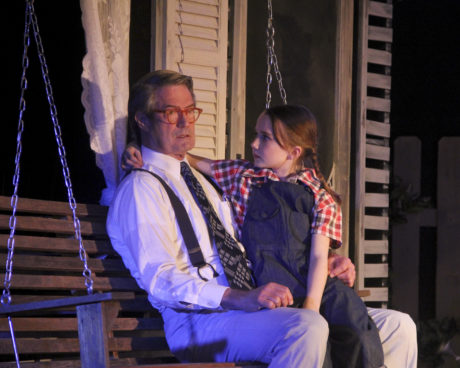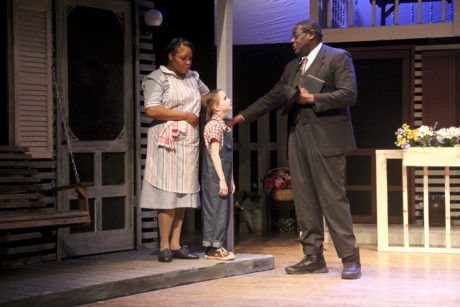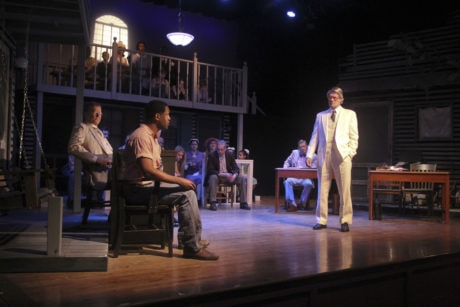Nestled into a quiet corner of Old Town Alexandria, the production of Harper Lee’s novel To Kill a Mockingbird (adapted for the stage by Christopher Sergel) at The Little Theatre of Alexandria was quietly powerful and thought provoking. Walking in to the theater opening night, it was safe to say most in attendance had read, watched, or seen this story before. The audience’s low murmur while waiting for the lights to dim was unmistakably attentive and anticipatory. With such an undercurrent undoubtedly in the cast and crew’s ears, the pressure must have been both exhilarating and utterly nerve-wracking as they prepared to put not only themselves but the audience into someone else’s shoes.

With the Finch’s house on the left and Boo Radley’s house on the right, a grown Jean Louise Finch played by Melissa Dunlap walked dreamily out to down center stage. The lighting low and her voice taking on the sing-song quality one associates with the South, the older Jean Louise’s narration was a thread running in and out of the entire performance. Dunlap’s voice and misty looks told us stories of the people on stage, of the times, and of the struggles of a little girl to understand. Never forceful or without purpose, Dunlap’s delivery balanced an actor’s difficultly to break the fourth wall and the narrators need to do just that.
Jean Louise’s younger self “Scout,” played by Olivia McMahon, was anything but dreamy or retrospective. Exuberantly present, Scout, along with her brother Jem, played by Jack Kearney, and new friend Dill, played by Nathaniel Burkhead, made up a rag-tag team of trouble, curiosity, bravery, and compassion that forced the adults of the play to remember what makes each of us human.

Lessons instilled in them by their father and the play’s main focus of examination and mystery, Atticus Finch as played by Richard Fiske. Through Fiske’s towering figure, Atticus stayed grounded in his moral compass as well as in a sense of duty to do what’s right even when it was hard or impossible to win. Level headed from start to nearly finish, Fiske’s portrayal clearly showed the introspective nature of every position Atticus took throughout the play. Mrs. Dubose, played by Patricia Spencer Smith, was cantankerous and opinionated, but Atticus taught Jem to see that she was also lonely and ailing. Mr. Cunningham, played by Zachary Todd, easily became swept into a mob passion that made him feel powerful, but Scout was also to see him as a man, a father, and desperately poor so as understand him and bring him to his senses.
The central figure in the children’s lives was the passionate and wise Brenda Parker as Calpurnia. Her constant guidance, watchful eye, and compassion for everyone who walked through her door was heart-warming to see. Parker gave Cal such a feisty spirit that she easily shone through, if not stole, every scene she was a part of.
Other notable performances included three key players in the courtroom scenes were Bob Ewell (Paul Donahoe), Mayella Ewell (Skye Lindberg), and Tom Robinson played by Larry Boggs. Through each of these incredibly difficult characters, the actors brought focused dedication to telling the truth—or at least their version of the truth. Donahoe’s sloppy, loud, erratic depiction of Bob Ewell was unsettling and created a knot in my stomach. A knot that twisted and squirmed as Lindberg’s Mayella—manipulated by her own terrible circumstances—screamed, cried, and lied while on the stand in an effort to save herself by condemning an innocent man. And most importantly Boggs’ painfully depiction how trapped Tom Robinson was by these events.
Off in the wings and in the background of this wonderful production was an equally large and talented crew. Producers Rachel Alberts, Bobbie Herbst, and Robert Kraus along with Director Frank Pasqualino teased out some truly touching moments while also putting the audience at the center of the courtroom drama, blocking so as to cast us as the jury. The set design by Dan Remmers further brought the streets of Maycomb county Alabama to life with slatted houses that seemed to splinter into a forest reaching out into the audience.
The lighting designed by Marzanne Claiborne superbly echoed the action on stage from dawn to dust or dream, and the Alan Wray’s sound design thoughtfully (and powerfully in the case of after the trial’s conclusion) enhanced each moment’s drama. Aiding the transformations of the actors on stage were Jean Schlicting and Kit Sibley with Costume Design, Donna Hauprich with Wardrobe, and Bill Brekke and Carla Crawford as Accent Coaches breathing life into each line.

It is both rare and special when a story comes along that can be told in any medium. From the page, to the screen, to the stage, To Kill a Mockingbird is one of those moments that is too powerful, too eye opening, too introspective and too important to be slowed down. As Atticus says, “You never really understand a person until you consider things from his point of view—” […] “—until you climb into his skin and walk around in it.” Luckily for us, thanks to this production by the Little Theatre of Alexandria, we have a chance to do just that.
Running Time: 2 hours and 30 minutes with a 15 minute intermission.
To Kill a Mockingbird plays through May 14, 2016 at the Little Theatre of Alexandria – 600 Wolfe Street, in Alexandria, VA. For tickets, call the box office at (703) 683-0496 or purchase them online.
RATING:






What a great and thorough review of all aspects of this show. So often those who work tirelessly behind the scenes go unnoticed. Here, I think only the set painter went without comment…a set painter brings life to the set and assists the lighting design if done well. Thank you for being inclusiveness in your comments. Community theatre survives on volunteers and they appreciate your feedback and praise.